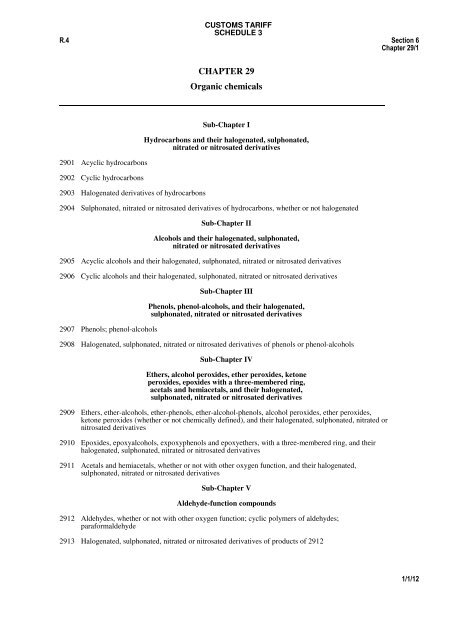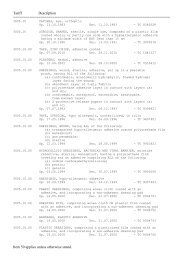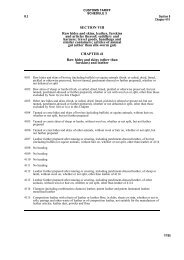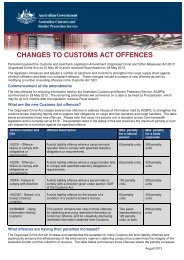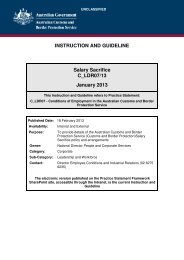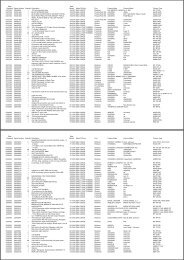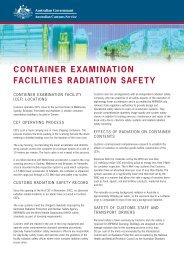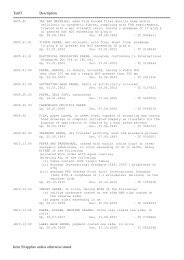CHAPTER 29 Organic chemicals
CHAPTER 29 Organic chemicals
CHAPTER 29 Organic chemicals
Create successful ePaper yourself
Turn your PDF publications into a flip-book with our unique Google optimized e-Paper software.
CUSTOMS TARIFF<br />
SCHEDULE 3<br />
R.4 Section 6<br />
Chapter <strong>29</strong>/1<br />
<strong>CHAPTER</strong> <strong>29</strong><br />
<strong>Organic</strong> <strong>chemicals</strong><br />
_____________________________________________________________________________________<br />
<strong>29</strong>01 Acyclic hydrocarbons<br />
<strong>29</strong>02 Cyclic hydrocarbons<br />
<strong>29</strong>03 Halogenated derivatives of hydrocarbons<br />
Sub-Chapter I<br />
Hydrocarbons and their halogenated, sulphonated,<br />
nitrated or nitrosated derivatives<br />
<strong>29</strong>04 Sulphonated, nitrated or nitrosated derivatives of hydrocarbons, whether or not halogenated<br />
Sub-Chapter II<br />
Alcohols and their halogenated, sulphonated,<br />
nitrated or nitrosated derivatives<br />
<strong>29</strong>05 Acyclic alcohols and their halogenated, sulphonated, nitrated or nitrosated derivatives<br />
<strong>29</strong>06 Cyclic alcohols and their halogenated, sulphonated, nitrated or nitrosated derivatives<br />
<strong>29</strong>07 Phenols; phenol-alcohols<br />
Sub-Chapter III<br />
Phenols, phenol-alcohols, and their halogenated,<br />
sulphonated, nitrated or nitrosated derivatives<br />
<strong>29</strong>08 Halogenated, sulphonated, nitrated or nitrosated derivatives of phenols or phenol-alcohols<br />
Sub-Chapter IV<br />
Ethers, alcohol peroxides, ether peroxides, ketone<br />
peroxides, epoxides with a three-membered ring,<br />
acetals and hemiacetals, and their halogenated,<br />
sulphonated, nitrated or nitrosated derivatives<br />
<strong>29</strong>09 Ethers, ether-alcohols, ether-phenols, ether-alcohol-phenols, alcohol peroxides, ether peroxides,<br />
ketone peroxides (whether or not chemically defined), and their halogenated, sulphonated, nitrated or<br />
nitrosated derivatives<br />
<strong>29</strong>10 Epoxides, epoxyalcohols, expoxyphenols and epoxyethers, with a three-membered ring, and their<br />
halogenated, sulphonated, nitrated or nitrosated derivatives<br />
<strong>29</strong>11 Acetals and hemiacetals, whether or not with other oxygen function, and their halogenated,<br />
sulphonated, nitrated or nitrosated derivatives<br />
Sub-Chapter V<br />
Aldehyde-function compounds<br />
<strong>29</strong>12 Aldehydes, whether or not with other oxygen function; cyclic polymers of aldehydes;<br />
paraformaldehyde<br />
<strong>29</strong>13 Halogenated, sulphonated, nitrated or nitrosated derivatives of products of <strong>29</strong>12<br />
1/1/12
Section 6<br />
Chapter <strong>29</strong>/2<br />
CUSTOMS TARIFF<br />
SCHEDULE 3<br />
Sub-Chapter VI<br />
Ketone-function compounds and quinone-function compounds<br />
<strong>29</strong>14 Ketones and quinones, whether or not with other oxygen function, and their halogenated, sulphonated,<br />
nitrated or nitrosated derivatives<br />
Sub-Chapter VII<br />
Carboxylic acids and their anhydrides, halides,<br />
peroxides and peroxyacids and their<br />
halogenated, sulphonated, nitrated<br />
or nitrosated derivatives<br />
<strong>29</strong>15 Saturated acyclic monocarboxylic acids and their anhydrides, halides, peroxides and peroxyacids; their<br />
halogenated, sulphonated, nitrated or nitrosated derivatives<br />
<strong>29</strong>16 Unsaturated acyclic monocarboxylic acids, cyclic monocarboxylic acids, their anhydrides, halides,<br />
peroxides and peroxyacids; their halogenated, sulphonated, nitrated or nitrosated derivatives<br />
<strong>29</strong>17 Polycarboxylic acids, their anhydrides, halides, peroxides and peroxyacids; their halogenated,<br />
sulphonated, nitrated or nitrosated derivatives<br />
<strong>29</strong>18 Carboxylic acids with additional oxygen function and their anhydrides, halides, peroxides and<br />
peroxyacids; their halogenated, sulphonated, nitrated or nitrosated derivatives<br />
Sub-Chapter VIII<br />
Esters of inorganic acids of non-metals and their salts,<br />
and their halogenated, sulphonated,<br />
nitrated or nitrosated derivatives<br />
<strong>29</strong>19 Phosphoric esters and their salts, including lactophosphates; their halogenated, sulphonated, nitrated or<br />
nitrosated derivatives<br />
<strong>29</strong>20 Esters of other inorganic acids of non-metals (excluding esters of hydrogen halides) and their salts;<br />
their halogenated, sulphonated, nitrated or nitrosated derivatives<br />
<strong>29</strong>21 Amine-function compounds<br />
<strong>29</strong>22 Oxygen-function amino-compounds<br />
Sub-Chapter IX<br />
Nitrogen-function compounds<br />
<strong>29</strong>23 Quaternary ammonium salts and hydroxides; lecithins and other phosphoaminolipids, whether or not<br />
chemically defined<br />
<strong>29</strong>24 Carboxyamide-function compounds; amide-function compounds of carbonic acid<br />
<strong>29</strong>25 Carboxyimide-function compounds (including saccharin and its salts) and imine-function compounds<br />
<strong>29</strong>26 Nitrile-function compounds<br />
<strong>29</strong>27 Diazo-, azo- or azoxy-compounds<br />
<strong>29</strong>28 <strong>Organic</strong> derivatives of hydrazine or of hydroxylamine<br />
<strong>29</strong><strong>29</strong> Compounds with other nitrogen function<br />
1/1/12
CUSTOMS TARIFF<br />
SCHEDULE 3<br />
R.5 Section 6<br />
Chapter <strong>29</strong>/3<br />
<strong>29</strong>30 Organo-sulphur compounds<br />
<strong>29</strong>31 Other organo-inorganic compounds<br />
Sub-Chapter X<br />
Organo-inorganic compounds, heterocyclic<br />
compounds, nucleic acids and<br />
their salts, and sulphonamides<br />
<strong>29</strong>32 Heterocyclic compounds with oxygen hetero-atom(s) only<br />
<strong>29</strong>33 Heterocyclic compounds with nitrogen hetero-atom(s) only<br />
<strong>29</strong>34 Nucleic acids and their salts, whether or not chemically defined; other heterocyclic compounds<br />
<strong>29</strong>35 Sulphonamides<br />
Sub-Chapter XI<br />
Provitamins, vitamins and hormones<br />
<strong>29</strong>36 Provitamins and vitamins, natural or reproduced by synthesis (including natural concentrates),<br />
derivatives thereof used primarily as vitamins, and intermixtures of the foregoing, whether or not in<br />
any solvent<br />
<strong>29</strong>37 Hormones, prostaglandins, thromboxanes and leukotrienes, natural or reproduced by synthesis;<br />
derivatives and structural analogues thereof, including chain modified polypeptides, used primarily as<br />
hormones<br />
Sub-Chapter XII<br />
Glycosides and vegetable alkaloids, natural or<br />
reproduced by synthesis, and their salts,<br />
ethers, esters and other derivatives<br />
<strong>29</strong>38 Glycosides, natural or reproduced by synthesis, and their salts, ethers, esters and other derivatives<br />
<strong>29</strong>39 Vegetable alkaloids, natural or reproduced by synthesis, and their salts, ethers, esters and other<br />
derivatives<br />
Sub-Chapter XIII<br />
Other organic compounds<br />
<strong>29</strong>40 Sugars, chemically pure, other than sucrose, lactose, maltose, glucose and fructose; sugar ethers, sugar<br />
acetals and sugar esters, and their salts, other than products of <strong>29</strong>37, <strong>29</strong>38 or <strong>29</strong>39<br />
<strong>29</strong>41 Antibiotics<br />
<strong>29</strong>42 Other organic compounds<br />
_____________________________________________________________________________________<br />
Notes.<br />
1.- Except where the context otherwise requires, the headings of this Chapter apply only to:<br />
(a) Separate chemically defined organic compounds, whether or not containing impurities;<br />
(b) Mixtures of two or more isomers of the same organic compound (whether or not containing<br />
impurities), except mixtures of acyclic hydrocarbon isomers (other than stereoisomers), whether or<br />
not saturated (Chapter 27);<br />
1/1/12
Section 6<br />
Chapter <strong>29</strong>/4<br />
CUSTOMS TARIFF<br />
SCHEDULE 3<br />
(c) The products of <strong>29</strong>36 to <strong>29</strong>39 or the sugar ethers, sugar acetals and sugar esters, and their salts, of<br />
<strong>29</strong>40, or the products of <strong>29</strong>41, whether or not chemically defined;<br />
(d) The products mentioned in (a), (b) or (c) above dissolved in water;<br />
(e) The products mentioned in (a), (b) or (c) above dissolved in other solvents provided that the<br />
solution constitutes a normal and necessary method of putting up these products adopted solely for<br />
reasons of safety or for transport and that the solvent does not render the product particularly<br />
suitable for specific use rather than for general use;<br />
(f) The products mentioned in (a), (b), (c), (d) or (e) above with an added stabiliser (including an anticaking<br />
agent) necessary for their preservation or transport;<br />
(g) The products mentioned in (a), (b), (c), (d), (e) or (f) above with an added anti-dusting agent or a<br />
colouring or odoriferous substance added to facilitate their identification or for safety reasons,<br />
provided that the additions do not render the product particularly suitable for specific use rather<br />
than for general use;<br />
(h) The following products, diluted to standard strengths, for the production of azo dyes: diazonium<br />
salts, couplers used for these salts and diazotisable amines and their salts.<br />
2.- This Chapter does not cover:<br />
(a) Goods of 1504 or crude glycerol of 1520.00.00;<br />
(b) Ethyl alcohol (2207 or 2208);<br />
(c) Methane or propane (2711);<br />
(d) The compounds of carbon mentioned in Note 2 to Chapter 28;<br />
(e) Immunological products of 3002;<br />
(f) Urea (3102 or 3105);<br />
(g) Colouring matter of vegetable or animal origin (3203.00.00), synthetic organic colouring matter,<br />
synthetic organic products of a kind used as fluorescent brightening agents or as luminophores<br />
(3204) or dyes or other colouring matter put up in forms or packings for retail sale (3212);<br />
(h) Enzymes (3507);<br />
(ij) Metaldehyde, hexamethylenetetramine or similar substances, put up in forms (for example, tablets,<br />
sticks or similar forms) for use as fuels, or liquid or liquefied-gas fuels in containers of a kind used<br />
for filling or refilling cigarette or similar lighters and of a capacity not exceeding<br />
300 cm 3 (3606);<br />
(k) Products put up as charges for fire-extinguishers or put up in fire-extinguishing grenades, of<br />
3813.00.00; ink removers put up in packings for retail sale, of 3824; or<br />
(l) Optical elements, for example, of ethylenediamine tartrate (9001).<br />
3.- Goods which could be included in two or more of the headings of this Chapter are to be classified in that<br />
one of those headings which occurs last in numerical order.<br />
4.- In <strong>29</strong>04 to <strong>29</strong>06, <strong>29</strong>08 to <strong>29</strong>11.00.00 and <strong>29</strong>13.00.00 to <strong>29</strong>20, any reference to halogenated,<br />
sulphonated, nitrated or nitrosated derivatives includes a reference to compound derivatives, such as<br />
sulphohalogenated, nitrohalogenated, nitrosulphonated or nitrosulphohalogenated derivatives.<br />
Nitro or nitroso groups are not to be taken as "nitrogen-functions" for the purposes of <strong>29</strong><strong>29</strong>.<br />
For the purposes of <strong>29</strong>11.00.00, <strong>29</strong>12, <strong>29</strong>14, <strong>29</strong>18 and <strong>29</strong>22, "oxygen-function" is to be restricted to the<br />
functions (the characteristic organic oxygen-containing groups) referred to in <strong>29</strong>05 to <strong>29</strong>20.<br />
Operative 1/1/12
CUSTOMS TARIFF<br />
SCHEDULE 3<br />
R.5 Section 6<br />
Chapter <strong>29</strong>/5
Section 6<br />
Chapter <strong>29</strong>/6<br />
CUSTOMS TARIFF<br />
SCHEDULE 3<br />
5.- (A) The esters of acid-function organic compounds of sub-Chapters I to VII with organic compounds<br />
of these sub-Chapters are to be classified with that compound which is classified in the heading<br />
which occurs last in numerical order in these sub-Chapters.<br />
(B) Esters of ethyl alcohol with acid-function organic compounds of sub-Chapters I to VII are to be<br />
classified in the same heading as the corresponding acid-function compounds.<br />
(C) Subject to Note 1 to Section VI and Note 2 to Chapter 28:<br />
(1) Inorganic salts of organic compounds such as acid-, phenol- or enol-function compounds or<br />
organic bases, of sub-Chapters I to X or <strong>29</strong>42.00.00, are to be classified in the heading<br />
appropriate to the organic compound;<br />
(2) Salts formed between organic compounds of sub-Chapters I to X or <strong>29</strong>42.00.00 are to be<br />
classified in the heading appropriate to the base or to the acid (including phenol- or enolfunction<br />
compounds) from which they are formed, whichever occurs last in numerical order in<br />
the Chapter; and<br />
(3) Co-ordination compounds, other than products classifiable in sub-Chapter XI or <strong>29</strong>41, are to<br />
be classified in the heading which occurs last in numerical order in Chapter <strong>29</strong>, among those<br />
appropriate to the fragments formed by “cleaving” of all metal bonds, other than metal-carbon<br />
bonds.<br />
(D) Metal alcoholates are to be classified in the same heading as the corresponding alcohols except in<br />
the case of ethanol (<strong>29</strong>05).<br />
(E) Halides of carboxylic acids are to be classified in the same heading as the corresponding acids.<br />
6.- The compounds of <strong>29</strong>30 and <strong>29</strong>31 are organic compounds the molecules of which contain, in addition to<br />
atoms of hydrogen, oxygen or nitrogen, atoms of other non-metals or of metals (such as sulphur, arsenic<br />
or lead) directly linked to carbon atoms.<br />
<strong>29</strong>30 (organo-sulphur compounds) and <strong>29</strong>31 (other organo-inorganic compounds) do not include<br />
sulphonated or halogenated derivatives (including compound derivatives) which, apart from hydrogen,<br />
oxygen and nitrogen, only have directly linked to carbon the atoms of sulphur or of a halogen which<br />
give them their nature of sulphonated or halogenated derivatives (or compound derivatives).<br />
7.- <strong>29</strong>32, <strong>29</strong>33 and <strong>29</strong>34 do not include epoxides with a three-membered ring, ketone peroxides, cyclic<br />
polymers of aldehydes or of thioaldehydes, anhydrides of polybasic carboxylic acids, cyclic esters of<br />
polyhydric alcohols or phenols with polybasic acids, or imides of polybasic acids.<br />
These provisions apply only when the ring-position hetero-atoms are those resulting solely from the<br />
cyclising function or functions here listed.<br />
8.- For the purposes of <strong>29</strong>37:<br />
(a) “hormones” includes hormone-releasing or hormone-stimulating factors, hormone inhibitors and<br />
hormone antagonists (anti-hormones);<br />
(b) “used primarily as hormones” applies not only to hormone derivatives and structural analogues<br />
used primarily for their hormonal effect, but also to those derivatives and structural analogues used<br />
primarily as intermediates in the synthesis of products of this heading.<br />
1/1/12
CUSTOMS TARIFF<br />
SCHEDULE 3<br />
R.6 Section 6<br />
Chapter <strong>29</strong>/7<br />
Subheading Notes.<br />
1.- Within any one heading of this Chapter, derivatives of a chemical compound (or group of chemical<br />
compounds) are to be classified in the same subheading as that compound (or group of compounds)<br />
provided that they are not more specifically covered by any other subheading and that there is no<br />
residual subheading named “Other” in the series of subheadings concerned.<br />
2.- Note 3 to Chapter <strong>29</strong> does not apply to the subheadings of this Chapter.<br />
Additional Notes.<br />
1.- In <strong>29</strong>20, “esters of inorganic acids” are to be taken to include carbonic and peroxocarbonic esters.<br />
2.- Paraquat dichloride of <strong>29</strong>33.39.00 includes paraquat dichloride with an emetic added for safety reasons,<br />
provided that the addition does not render the product suitable for specific use rather than for general<br />
use.<br />
1/1/12


